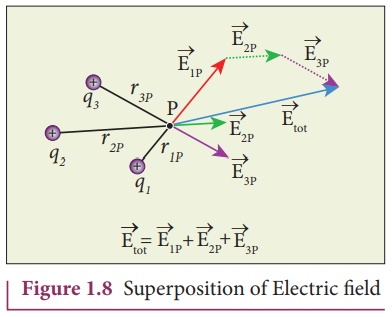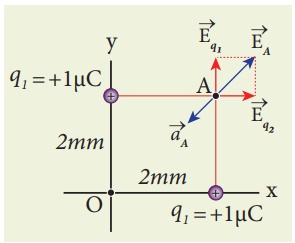Chapter: 12th Physics : Electrostatics
Electric field due to the system of point charges
Electric field due to the system
of point charges
Suppose a number of
point charges are distributed in space. To find the electric field at some
point P due to this collection of point charges, superposition principle is
used. The electric field at an arbitrary point due to a collection of point
charges is simply equal to the vector sum of the electric fields created by the
individual point charges. This is called superposition of electric fields.
Consider a collection of
point charges q1 , q2 ,q 3
..........qn located at various points in space. The
total electric field at some point P due to all these n charges is given by

Here r1P , r2P
,r3P ..........rnP are the distance of the the charges q1
, q2 ,q3 .......... qn
from the point respectively. Also ^r1P , ^r2P , ^r3P
..........r ^nP
are the corresponding unit vectors directed from q1, q2
,q3 ..........qn to P.
Equation (1.7) can be
re-written as,

For example in Figure
1.8, the resultant electric field due to three point charges q1
,q2 ,q3 at point P is
shown.
Note that the relative
lengths of the electric field vectors for the charges depend on relative
distances of the charges to the point P.

EXAMPLE 1.7
Consider the charge
configuration as shown in the figure. Calculate the electric field at point A.
If an electron is placed at points A, what is the acceleration experienced by
this electron? (mass of the electron = 9.1 × 10-31 kg and charge of
electron = −1.6 × 10-19 C)

Solution
By using superposition principle,
the net electric field at point A is

where r1A and r2A are the distances of point A from the two charges respectively.

which is the unit vector along OA as shown in the figure.

The acceleration experienced by an electron placed at point A is

The electron is accelerated in a direction exactly opposite to ![]() A.
A.
Related Topics